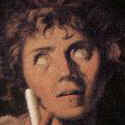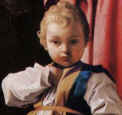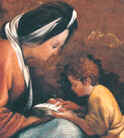— Schedoni's untimely death (perhaps suicide owing to gambling debts) brought an abrupt end to the career of one of the most attractive painters of the seventeenth century and an eccentric exponent of the Emilian school. He was connected to the Farnese courts in Parma and Modena where he both assimilated and reworked a variety of different influences. Among them we can see both a direct line to Correggio, the finely detailed way of working used by the Carracci cousins, and all of the latest trends from Rome. Ranuccio Farnese sent Schedoni to Rome at the close of the sixteenth century, but he soon returned to Emilia and settled in Parma. It was there that he painted a small but fascinating group of masterpieces in a severe and noble style. At the same time his works were warmed by a light that softened fabrics and added delicacy to expressions. Although the dates and places were different, Schedoni's personal story ran along similar lines to Caravaggio's. His violence and trouble-making got him into endless scrapes with the law, while his passion for tennis was so great that he almost lost the use of his right hand.
— He was the son of Giulio Schedoni, a mask-maker, who served the Este court in Modena and the Farnese in Parma; in 1598 Schedoni and his father are recorded as residing in Parma, both serving the court. In 1595 Ranuccio I, Duke of Parma, sent Bartolomeo to Rome, to be trained in the studio of Federico Zuccaro. Schedoni fell ill shortly after, however, and returned to Parma. His earliest surviving works show no evidence of Roman influence. He is said to have been a student of Annibale Carracci in Bologna, but there are reasons to doubt this. First, this would have been prior to Annibale’s departure for Rome in 1595, a period when Schedoni was still apparently under his father’s care. Secondly, the early pictures indicate that initially his style was formed primarily by studying the work of Correggio in Parma. To a lesser degree he was influenced by the Parmesan culture of Parmigianino, Girolamo Mazzola Bedoli, and Michelangelo Anselmi. As a boy in Parma he was also known to have frequented the studio of the Fleming Giovanni Sons [1548–1611]. His painting was also enriched by his knowledge of the work of Nicolň dell’Abate in Modena, and Dosso Dossi and Scarsellino in Ferrara. Once these initial influences were assimilated, however, Schedoni’s stylistic development was guided primarily by the innovations of the Carracci.
— Schedoni fu nel 1595 a Roma nella bottega di Federico Zuccari, ma la sua cifra espressiva appare influenzata piuttosto dalla cultura bolognese rinnovata dai Carracci. Fra il 1602 e il 1606 lavora per la corte estense di Modena; nel 1607 partecipa con Ercole dell'Abate alla decorazione con tele riportate del soffitto della Sala del Consiglio nel Palazzo Comunale. La sua gamma cromatica, squillante di colori, si rannuvola via via, attraverso un piu' serrato confronto con Ludovico Carracci. In opere come l'Annunciazione di Formigine o la Madonna e Santi, eseguita per la parrocchiale di Fanano, ma subito pretesa per se' da Ranuccio Farnese (1608), il ricupero di Correggio, che resta una delle costanti del percorso di Schedoni, si attua attraverso l'intenso chiaroscuro di Ludovico. Dal 1608 diviene pittore di corte di Ranuccio Farnese a Parma; numerosi dipinti di committenza farnesiana si trovano ora nella Pinacoteca di Capodimonte a Napoli. La sua opera godette di una straordinaria fortuna, al punto da dar luogo a una serie enorme di derivazioni e di copie, che rendono oltremodo difficile la ricomposizione del suo catalogo.
— The Charity (1611, 1123x760pix, 107kb) _ This painting is also one of Schedoni's best-known works. The rather generic title is not really sufficient as the canvas appears to be describing a real episode.
 Schedoni gave his characters an amazing degree of consistency and peremptoriness.
The blind boy staring out at us with empty eyes is one of the strongest
images ever produced in the seventeenth century.
Schedoni gave his characters an amazing degree of consistency and peremptoriness.
The blind boy staring out at us with empty eyes is one of the strongest
images ever produced in the seventeenth century. As always, Schedoni also drew on Correggio's legacy for touches of moving
lyricism, such as the little boy on the right. But the real magic of the
painting lies yet again in the highly personal way that Schedoni used light,
both penetrating and delicate at the same time. His light brings out the
colored fabrics while casting long shadows over parts of the faces.
As always, Schedoni also drew on Correggio's legacy for touches of moving
lyricism, such as the little boy on the right. But the real magic of the
painting lies yet again in the highly personal way that Schedoni used light,
both penetrating and delicate at the same time. His light brings out the
colored fabrics while casting long shadows over parts of the faces. — The Deposition (1613, 821x1030pix, 115kb)
— The Two Marys at the Tomb (1613, 770x1095pix 98kb) _ These two memorable masterpieces, The Two Marys and The Deposition, give us cause to regret the brevity of Bartolomeo Schedoni's tormented artistic life. They show that he really would have been able to point Baroque painting in an original and intense direction. The way he blocked out gestures, used violent light and dazzling whites, combined with perfect clarity of detail to produce an almost metaphysical effect.
— Mary Teaches Reading to the Child Jesus (34x45cm; 366x497pix, 57kb) _ Con affettuosa inclinazione narrativa l'immagine mostra la Vergine intenta ad insegnare a leggere al Bambino. Un'atmosfera di domestica serenità si diffonde nel paesaggio rapidamente abbozzato, dove il cagnolino dorme acciambellato accanto al cestino da lavoro abbandonato.
 La
dolcezza dell'ispirazione e' propria di Bartolomeo Schedoni, del quale si
puo' richiamare a confronto la bella Annnciazione di Formigine analogamente
ripensata in chiave di accostante naturalezza. E' evidente come allo Schedoni,
al quale si deve l'avvio del moderno corso della pittura modenese, la dimensione
affabile del racconto e la scioltezza della conduzione esibite dei modelli
carraceschi furono determinanti per liberarsi dagli schemi ormai intellettualizzati
e cifrati del tardo manierismo vigente ancora a Modena.
La
dolcezza dell'ispirazione e' propria di Bartolomeo Schedoni, del quale si
puo' richiamare a confronto la bella Annnciazione di Formigine analogamente
ripensata in chiave di accostante naturalezza. E' evidente come allo Schedoni,
al quale si deve l'avvio del moderno corso della pittura modenese, la dimensione
affabile del racconto e la scioltezza della conduzione esibite dei modelli
carraceschi furono determinanti per liberarsi dagli schemi ormai intellettualizzati
e cifrati del tardo manierismo vigente ancora a Modena.Se nel dipinto alcuni dettagli rivelano un garbo non comune, talune incertezze dell'esecuzione potrebbero metterne in dubbio l'autografia. Ma i "difetti" del garbatissimo quadretto in realta' sono imputabili alla tecnica molto rapida; il supporto ligneo e' stranamente usato anche in altri casi da Schedoni per fermare una prima idea in vista di dipinti piu' impegnativi e si accompagna a una fattura di getto, quasi corsiva, ma di accattivante immediatezza.
_ Schedoni painted also a The Holy Family with the Virgin teaching the Child to Read (1615, 34x28cm; 420x320pix, 35kb) where Jesus is much younger, still a baby certainly less than 2 years old. In it the close-knit composition, the golden light, and the natural gestures of the figures create a powerful sense of human intimacy and show the influence of Correggio
— Deposition (1613; 588x750pix, 53kb)